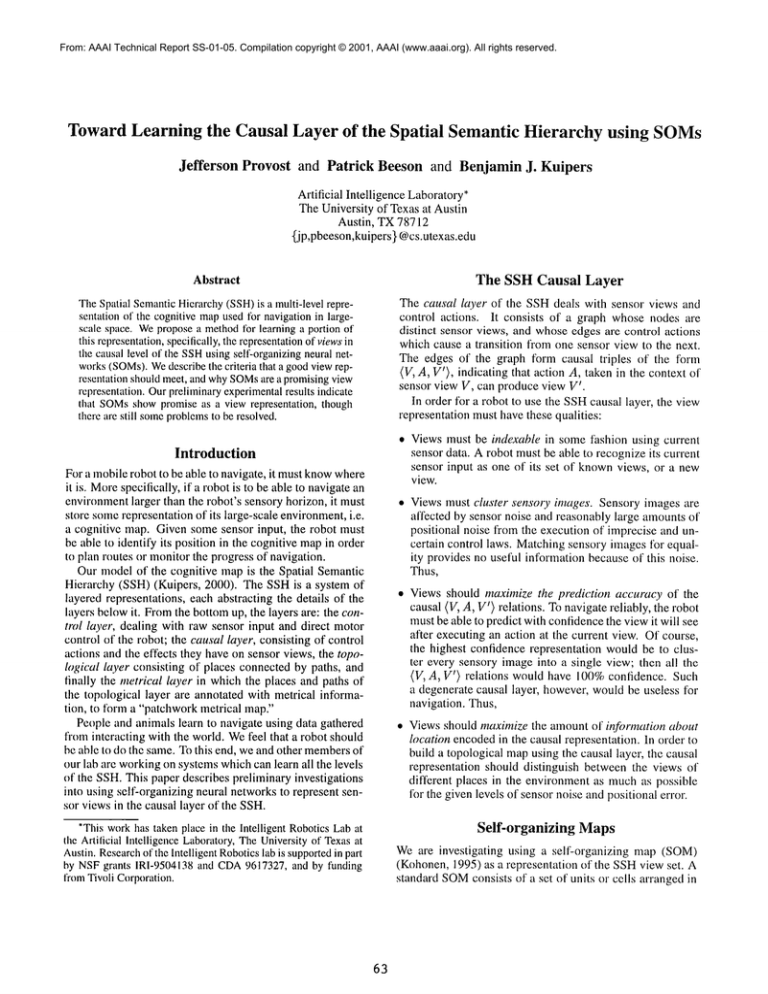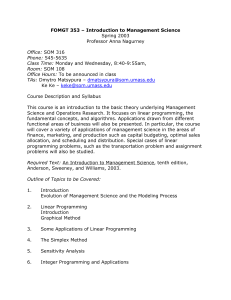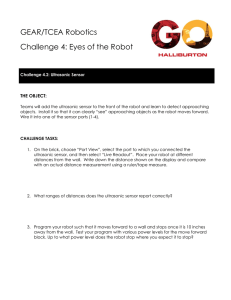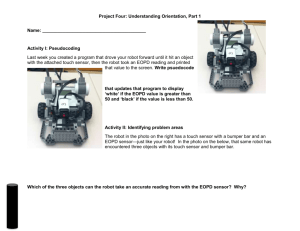
From: AAAI Technical Report SS-01-05. Compilation copyright © 2001, AAAI (www.aaai.org). All rights reserved.
TowardLearning the Causal Layer of the Spatial Semantic Hierarchy using SOMs
Jefferson
Provost
and Patrick
Beeson and Benjamin J. Kuipers
Artificial Intelligence Laboratory*
The University of Texasat Austin
Austin, TX 78712
{jp,pbeeson,kuipers} @cs.utexas.edu
Abstract
The SSH Causal
TheSpatial SemaqticHierarchy(SSH)is a multi-levelrepresentation of the cognitivemapusedtbr navigationin largescale space. Weproposea methodfor learning a portion of
this representation,
specifically,the representation
of viewsin
the causal level of the SSHusingsell-organizingneuralnetworks(SOMs).
Wedescribethe criteria that a goodviewrep,’eseqtation shouldmeet, and whySOMs
are a promisingview
representation.Ourpreliminaryexperimental
results indicate
that SOMs
showpromiseas a view representation, though
there are still someproblems
to be resolved.
Layer
The causal layer of the SSHdeals with sensor views and
control actions. It consists of a graph whose nodes are
distinct sensor views, and whoseedges are control actions
whichcause a transition from one sensor view to the next.
The edges of the graph form causal triples of the form
(V, A, V’), indicating that action A, taken in the context ol’
sensor view V, can produce view V’.
In order for a robot to use the SSHcausal layer, the view
representation must have these qualities:
¯ Views must be indexable in some fashion using current
sensor data. A robot mustbe able to recognize its current
sensor input as one of its set of knownviews, or a new
view.
Introduction
For a mobilerobot to be able to navigate, it must knowwhere
it is. Morespecifically, if a robot is to be able to navigatean
enviromnentlarger than the robot’s sensory horizon, it must
store somerepresentation of its large-scale environment,i.e.
a cognitive map. Given somesensor input, the robot must
be able to identify its position in the cognitive mapin order
to plan routes or monitorthe progress of navigation.
Our modelof the cognitive mapis the Spatial Semantic
Hierarchy (SSH) (Kuipers, 2000). The SSHis a system
layered representations, each abstracting the details of the
layers belowit. Fromthe bottomup, the layers are: the control layer, dealing with raw sensor input and direct motor
control of the robot; the causal layer, consisting of control
actions and the effects they have on sensor views, the topological layer consisting of places connected by paths, and
finally the metrical layer in whichthe places and paths of
the topological layer are annotated with metrical information, to form a "patchworkmetrical map."
People and animals learn to navigate using data gathered
fi’om interacting with the world. Wefeel that a robot should
be able to do the same. To this end, we and other membersof
our lab are workingon systems whichcan learn all the levels
of the SSH.This paper describes preliminary investigations
into using self-organizing neural networksto represent sensor viewsin the causal layer of the SSH.
¯ Views must cluster sensoO, images. Sensory images are
affected by sensor noise and reasonably large amountsof
positional noise fi’om the execution of imprecise and uncertain control laws. Matchingsensory images for equality provides no useful informationbecauseol’ tiffs noise.
Thus,
¯ Views should maximize the prediction accuracy of the
causal (V, A, ~) relations. To navigate reliably, t he robot
mustbe able to predict with confidencethe viewit will see
after executing an action at the current view. Of course,
the highest confidence representation wouldbe to cluster every sensory image into a single view; then all the
IV, A, V’) relations would have 100%confidence. Such
a degenerate causal layer, however,wouldbe useless for
qavigation. Thus,
¯ Views should maximize the amountof information about
location encodedin the causal representation, in order to
build a topological mapusing the causal layer, the causal
representation should distinguish between the views of
different places in the environmentas muchas possible
for the given levels of sensor noise and positional error.
*Thisworkhas taken place in the Intelligent RoboticsLabat
the Artilicial IntelligenceLaboratory,TheUniversityof Texasat
Austin.Research
of the Intelligent Roboticslab is supportedin part
by NSFgrants IRI-9504138and CDA
9617327, and by funding
fromTivoli Corporation.
Self-organizing
Maps
Weare investigating using a self-organizing map (SOM)
(Kohonen,1995) as a representation of the SSHview set.
standard SOM
consists of a set of writs or cells arranged in
63
¯ Data- and sensor- generality - Because they operate on
any input that can be expressed in the form of a vector,
they are not specific to range-sensors or office environmerits as occupancygrids and segment/wallfeature representations are.
¯ Goodintuitive fit to task - As our results showbelow,
a SOMgenerates views that look to the humaneye like
the sensor imagesthey represent. Furthermore,the representation distinguishes betweenviews of places that look
different, while aggregating views fl’om places that look
similar.
360-D weight vector
image of fhe input vector
(maximally respnding unit)
2-D nei hborhood
Figure 1:5x5 Self-organizing Map.In training, each sensor
imageis comparedwith the weightvector of each cell, and the
weightsare adaptedso that overtimeeachcell respondsto a different portionof tile inputspace.
a lattice, l The SOMtakes a continuous-valued vector X as
input and returns one of its units as the output. Eachunit has
a weight vector IV/of the same dimension as the input. On
the presentation of an input, each weightvector is compared
with the input using the Euclidean distance and a winneris
selected as arg mini [IWi- x II.
In training, the weightvectors in the SOM
are initialized
to randomvalues. Whenan input vector is presented, the
winningunit’s weights are adjusted to moveit closer to the
input vector by someh’action of the distance betweenthe
input and the weights (the learning rate). In addition, the
units ill the neighborhoodof the lattice near the winnerare
adjusted towardthe input by a lesser amount.
Training begins with initially large values for both the
learning rate and the neighborhoodsize. As training proceeds through numerouscycles, or epochs. In each epoch,
the full set of training vectors is presented in a newrandom
order, as the learning rate and neighborhoodare gradually
annealedto very small values. Asa result, early training orients the mapto cover the gross topology of the input space,
and as the parameters are annealed, finer grained structure
of the input space emerges.
Ill our implementation, the trained SOMis used as the
view matcher: it takes a sensory imageas input and the winningunit is taken to be the viewat the current state.
Self-organizing mapshave several properties which suggest that they will lend themselves well to representing
views:
Clustering with topology preservation - SOMspartition
the input space into a set of clusters that preserves the
topology of the original input space in reduced dimensions2. Thussimilar views will be placed near one another
ill the SOM.
Note: PIoI~ :are not all lhe samescale
-
.
Figure 2: Development
of a SOM
unit. Plot of six snapshots
in the development
of a single unit in the SOM
overtile courseof
training.
Related work
Many researchers have tried a number of unsupervised
learning methods in robot localization, including SOMs
(Nehmzow& Smithers, t991), growing cell structures
(Duckett & Nehmzow,
2000), nearest neighbor (Duckett
Nehmzow,1998), and local occupancy grids (Yamauchi
Langley, 1997). Duckett & Nehmzow
tested these methods
ill the samelocalization task, and comparedlocalization accuracy against computationalcost for all the algorithms.
The major differences between these efforts and ours is
that they all use their respective methodsto identify locations, while we are attempting only to distinguish and classify views. This frees us fl’om the need to eliminate perceptual aliasing 3 entirely at the view-recognitionlevel. The
SSHmodel anticipates that someplaces may be indistinguishable at the view level, and mechanislnsare built into
the topological level to deal with this. (Kuipers & Byun,
1988, 1991)
Nevertheless, these works, particularly that of Duckett &
Nehmzow,contain manygood ideas which bear further investigation in the context ot’ the SSH.For l’urther discussion,
see the future worksection, below.
Experiment
Wetested SOMs
as a view-representation on a hand-selected
set of 10 "distinctive states," chosento represent possible
=Thelattice is usually, but not necessarily,a 2Drectangular
grid.
21nthis context,topologyrefers to the topologyof the space
of sensor images,not the topologyof placesand paths in the SSH
topologicallayer.
3Theterm for tile situation whentwoor moredistinct states
in the environment
are indistinguishableto the robot’s perceptual
apparatus.
64
termination points of control laws in the SSH.The states are
shownin Figure 4. Each state is a pose in the environment
defined by the robot’s position and orientation (x, y, 0).
model positional uncertainty, several samples were taken
from each state in which the canonical pose for that state
was randomlyperturbed in these ranges:
-50(hmn _< Ax,Ay < 500mm
-10° _< A0 < o10
All data were generated with the Flat robot simulator
(Hcwett et al., 1999) designed to simulate Vulcan, one of
the physical robots in our lab. The simulated robot is con°tigured with two range-finders sampling 180 ranges at 1
intervals around a semi-circle. The range-finders are oriented at -45° and +45° from the robot’s centerline, so that
they cover a 270° arc aroundthe robot, with 90° of overlap
directly in front. The maximum
range of the range-finders
is 25m.The environmentis a simulated layout of the fourth
floor of Taylor Hall at the Universityof Texasat Austin, with
walls, doorways, doors, etc. The noise model gives each
4.
point a 40%probability of a 4-4cmerror (20%+4, 20%-4)
The resolution is sufficient to makeout features as small as
5
I ()()nml.
Wetrained a 5x5 SOMfor 5000 epochs on 10 images
from each distinctive state. The sensory images were 360dimensionalvectors constructed by concatenating the output
of the two range-tinders.
Results
iii!iii!il
~’C~
State3
State 4
10
10
:iiiii!iiiii~!~
State S
State6
io
I
0
State 7
!
I0
I
state,g
!
Figure 3: Histograms
of SOM
outputfor each state. Eachgrid
is a histogramof the winningcell output of the 5x5SOM
for each
sensorimagefromeachof the 10 distinctive states. Darkershading
meansmoreimagesweremapped
to that cell. States 1,5, 7, 8, and
9 showstrongly focusedresponses. While2, 3, 4 and 6 showunfocusedresponses.Thestates correspond
to the states in Figure4.
Theweightvectorsof the mapcells are shownin Figure5.
and Discussion
either side. Onefeature of the standard SOM
learning algorithm is that it automaticallyassigns the cells to cover areas
of the input space in proportionto their representation in the
training data. Becausescans 2, 3, 4, and 6 are close to one
another in the input space, a large amountof the SOM
representation is devoted to covering this space, posing problems
for view representation which we address helow.
View Response to Distinctive States
To measure howwell tile trained SOMfunctions as a view
representation, we presented the trained SOMwith all the
imagesfi’om all 10 distinctive states, and created histograms
of the winningcells for each state (Figure 3). Theresults are
mixed.States 1, 5, 7, 8, 9, and, to a lesser degree, 10, show
strongly focusedresponses, with all or nearly all imagesfor
a view activating the samecell, with the few "misses" activating nearbycells in the map.States 2, 3, 4, and 6, on the
other hand, have broad unfocused responses. These are the
states from the central corridor mentionedabove. Because
the images of these states are so muchalike, tile SOMhas
over-fit the data and created moreviews than are neededto
represent the input data. This is a potential problemfor use
of the SOM
as a view representation. Weare investigating a
numberof possible solutions, whichare discussed below.
Figures 6 and 7 illustrate the difference in SOM
response
4Thisis a morerealistic noise modelfor the SICKlaser range
scannersused on the physical robot than either Gaussianor uniformlydistributednoise.
5Thedepth of the "dent" forrned by a doorwaywith a closed
our
State
2
m
S
Learned Views
Wecan see fl’om tile following figures that the trained map
learned a view representation with a strong qualitative match
to the sensor images.Figure 2 plots a single cell at six steps
in the training. 6 The unit begins with randomweights, and
gradually grows to closely match the view of one of the
states in the training data. Figure5 plots the weightvector of
each cell in the trained SOMas a range-finder image. Each
cell’s weight vector can be thought of as the sensor image
to which that cell responds the most strongly. Manyof the
cells very closely resemble typical range scans that would
be seen in the states in Figure 4, others resemble averages
of manynoisy scans |i’om one state, or combinationsof the
scans of distinct but similar states.
Despite this visible similarity, the learned representation
is not perfect. In particular, notice that manyof the cells
on the left side in Figure 5 are very similar to one another.
These cells represent views learned from images of states
2, 3, 4, and 6. As you can see from Figure 4 these states
are all in the long central corridor of the environment,facing walls or doorwayswith long open reaches of corridor to
door ill
State1
environmellt.
¢’ln all the plots, the rangesfromthe twooverlapping
rangefinders, or the corresponding
SOM
weights,are plotted on a single polar graphwiththe centerlineof the robotorientedvertically.
65
!7!7..............
............
Figure 4: Distinctive states in tile environment.Thesimulatedrobot environmentused in our experiment,with the 10 distinctive states
used lbr training marked.
¸:..
!i
l
/
\’\ :-:’:"I
\
//
( ..’-:.:=_...:.,:..1(
l :’ I’Y"*
\
/
/
\
7:
~
\
,j.
~
i/ill
;
/
~’~
I
,
\
i
/
"’,
.....
~i-.:....
.
~,,
],
2
Y\
z
Figure 5: SOM
WeightVectors as Views. Here the weight vector of each cell in the 5x5 SOM
is plotted as a range-finder image. Each
cell’s weightvector can be thoughtof as the sensor image,or view, to whichthat cell respondsmoststrongly. Theseimagescorrespondto the
grid cells in Figures1, 3, 6, and7. Notethe similar viewsrepresentedalongthe left side of the map,contributingto the poormapresponses
in states 2, 3, 4, and6.
66
State7
State2
~
XI0
X I0!
0 I II i ,Mi0
4
x I0
4
4
× IO
I I I [ I II0
xlO
xIO
4
4
4
I I IlI
xlO
xlO
I I I I I II
4
X 10
12
XIO
12
Figure 6: SOM
activation response for state 7. The response
activationsof the SOM
for all 10 sensoryimagesof state 7, a state
witha stronglyfocusedhistogramin Figure3. Notethat all the responsesare nearlyidentical. (Darkershadingmeansa closer match
to the input.)
Figure 7: SOM
activation response for state 2. Tile response
activationsof the SOM
for all 10 sensoryimagesof state 2, oneof
the least focusedstates in Figure3. Notethe differencein responses
for different images.(Darkershadingmeansa closer matchto the
input.
betweenthe states that have beenover-fit and those that have
not. Theyplot the activation of the SOM
to each individual
view from states 7 and 2 respectively. State 7 had the most
strongly focused response in the histograms, while state 2
had a very poorly focused response. Figure 6 clearly shows
that the mapresponse for state 7 is nearly identical for all
sensor images. In Figure 7 the responses to the views of
state 2 differ greatly, not only in the winningcell, but in the
general pattern of activation. Matchingthe activated cells
from the histograms of states 2 and 7 in Figure 3 with the
view images in Figure 5, we see that the single view activated for state 7 is unlike any of the other viewsrepresented
in the map.Thefive views activated for state 2, on the other
hand, are all very similar to one another.
Figure 8: Perceptualaliasing. Tile tile left and center images
are scans fromtwodifferent distinctive states in the environment
(places1 and9). Bothscans’best matchis the viewonthe right.
Perceptual Aliasing
Thehistogramsof states 1 and 9 in Figure 3 display a classic
case of perceptual aliasing. Thesetwo states have identical
response histogramsin the SOM.This is expected if the metrical differences between the images of the two roomsare
within the boundsof the positional error and sensor noise
in the data. Figure 8 showstwo typical sensor imagesfrom
these two states, along with the view of the most common
matching cell for each. In these two, the robot was positioned inside a roomfacing the doorway,with similar geometry of walls and corners on all sides. Thesestates are both
represented by the same view in our SOM.
67
Continuing and Future work
Weare continuing to investigate using SOMsfor view representation on several fronts:
Eliminating over-fitting
The most obvious area for continuing development is the
elimination of the over-litting problems mentioned above.
Wesee several possible waysof doing this.
One simple meansof eliminating over-fitting is to use
a smaller SOM.Fewertotal cells meansfewer cells to allocate to any one area of the search space. The problem
with this methodis that it brings up the question of howto
choose a good mapsize for an environment. Toosmall a map
will cause unnecessaryperceptual aliasing. Furthermore,we
wouldlike for our robots to be able to explore and mapan
environmentwith little or no prior knowledgeof the number
of distinct viewsthat they will need.
Twomethods, active training and growing SOMs,may
lend themselves to this problem. In active learning, the
learning rate of the SOM
is dynamic,rather than on a fixed
schedule. For example,if the learning rate is proportional
to the distance of the training vector fromthe winningcell,
then areas of the space that are already strongly represented
by one cell will not receive a large allocation of cells from
the map. Growing SOMs(Fritzke, 1996) are variants
ordinary SOMsthat add cells to the networkincrementally
based on criteria such as the cumulative error in the winning nodes. This wouldallow the networkto add cells only
in areas of the input space wherethe coverage is poor. In
addition, growing SOMseliminate the need to guess in advance the size of the networkneededto adequately represent
the views, makinggrowingSOMsmore suitable for lifelong
learning.
and integrate a learned causal layer into a workingnavigation system based on the SSH,with the ultimate goal of a
systemthat learns all the levels of the SSH.
References
Duckett, T., and Nehmzow,U. 1998. Mobile robot selflocalization and measurementof performance in middle scale environments. Robotics and AutonomousSystems 24(1-2).
Duckett, T., and Nehmzow,U. 2000. Performance comparison of landmarkrecognition systems for navigating
mobile robots. In Proc. 15th National Conf on Artificial Intelligence (AAAI-2000),826-83I.
Fritzke, B. 1996. Growingself-organizing networks - why?
In Verleysen, M., ed., ESANN’96:Eul~)pean Symposium on Artificial Neural Networks, 61-72. Brussels:
D-FactoPublishers.
Hewett, M.; Remolina, E.; Browning, R.; Nguyen,H.; Lee,
W.-Y.; and Kay, B. 1999. The ltat 2-d robot simulator.
http://www.cs.utexas.edu/users/qr/robotics/flat/.
Kohonen,T. 1995. Se!f-Organizing Maps. Springer.
Kuipers, B. J., and Byun, Y. T. 1988. A robust qualitative
methodfor spatial learning in unknownenvironments.
In Proc. 7th National Con[~on Artificial h~telligence
(AAAI-88), 774-779. Los Altos, CA: Morgan Kauf-
Quantitative evaluation
So far, our evaluation of the SOM
as a view representation
has been primarily qualitative. Somequantitative measure
of the fitness of a particular view representation is needed
to rigorously evaluate this and other representations. One
possibility is to use the prediction accuracyof the (V, A, V’)
as the metric. This will be possible whenwe have integrated
the SOMview representation into an SSH-basedexploration
routine on a real or simulatedrobot.
Anotherpossible metric is the Uncertainty Coefficient U,
used by Duckett &Nehmzow
(2000). It is an entropy-based
metric for measuringthe quality of landmark-basedrecognition systems, and is suitable for measuringsystems learned
Ihrough unsupervised methods such as SOMsor discrete
clustering algorithms.
Oneexciting possibility, oncea goodmetric has been discovcred, is to implementon-line, adaptive learning by evaluating the quality of the view representation continually as
the robot explores, and feed the results back to the active
training, or growingSOM,to modifyits learning as it explores.
lnann.
Kuipers, B. J., and Byun, Y.-T. 1991. A robot exploration
and mappingstrategy based on a semantic hierarchy of
spatial representations. Journal o[’Robotics and AutonomousSystems 8:47-63.
Kuipers, B. J. 2000. The spatial semantic hierarchy. Artificial Intelligence 119:191-233.
Nehmzow,U., and Smithers, T. 1991. Mapbuilding using self-organizing networksin really useful robots. In
Proc. SAB’91.
Yamauchi,B., and Langley, E 1997. Place recognition in dynamic environments. Journal of Robotic Systems 14(2).
Conclusion
Self-organizing mapsshowpromise as a methodfor learning
to recognizesensor views in the Spatial SemanticHierarchy.
On our test data, a SOMdevelops a strong, focused representation for views of several states in the environment.The
remaining states’ representations suffer because the SOM
over-lit the data, encoding positional noise in the views.
Modifying the SOMlearning algorithm either through the
use of active training or growingSOMsshould allow learning a strong representation of the viewsof all states without
over-litting.
In our continuingworkwe hope to establish a quantitative
measure of the goodness of a learned view representation,
68







